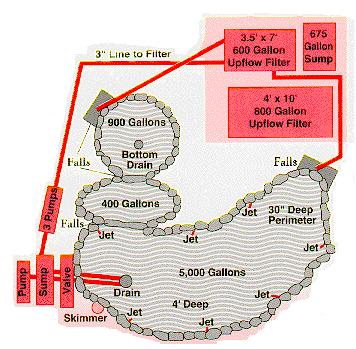|
This is a diagram of our pond that appeared in the Spring 1996 issue of the Nishigigoi International magazine. We have a 2 page spread of pictures of our Koi pond in that issue. |
 |
I Like that !
|
This is a diagram of our pond that appeared in the Spring 1996 issue of the Nishigigoi International magazine. We have a 2 page spread of pictures of our Koi pond in that issue. |
 |
|
The following pictures show the removal of the first 1500 gallon pond and a few of the major construction phases of the new 5000 gallon pond. From forms to function, the overall construction lasted about two months.
The first part of the Woodford Project was to remove the old 1500 gallon pond. The old pond was the first attempt to construct a Koi pond. Most major mistakes in pond construction were accomplished in the first project. The removal of the old pond started around the end of March, 1992.
The trench for the sump pump. This will be the deepest spot in the pond at 4 feet.
"Mr. Fridentine" makes the final inspection of the reinforcing members before
the concrete, also known as "mud", is poured.
The mud has dried and is set. Now, the moss rocks, that define the pond edge, are set in
place before the landscaping defines the pond's character.
Once the new pond was filled and the water stabilized, the Koi were added one by one.
Teel pumps - 1/4 and 1/5 hp - move the water. Only the ¼ is used in the winter.
This is what we wake up to in the morning. It adds stress to my life knowing that these
Koi have no control over the DOW Jones Industrial averages. |

Return to the Fridenstine Pond Discussion